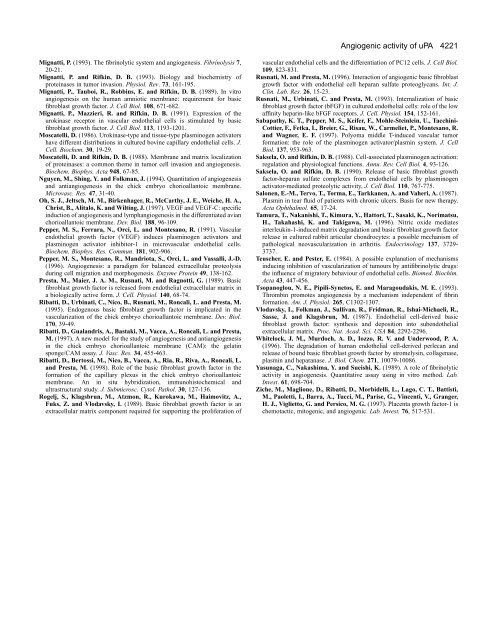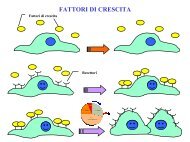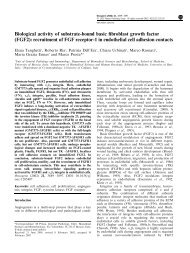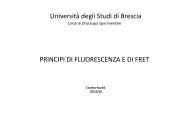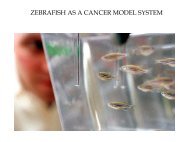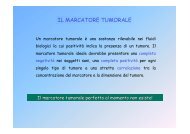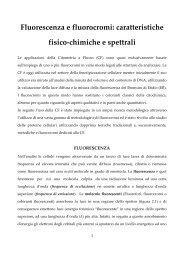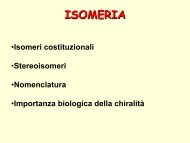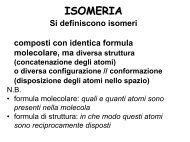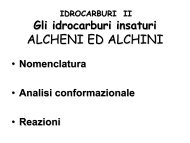4220D. Ribatti and othersin the CAM, as suggested by the residual <strong>angiogenic</strong> <strong>activity</strong>exerted by PMSF-treated uPA. Relevant to this point, previousstudies have shown that purified uPA exerts an uPARdependentmitogenic <strong>activity</strong> on human fibroblasts that cannotbe mimicked by ATF alone, suggesting that both receptoroccupancy and catalytic <strong>activity</strong> may play a <strong>role</strong> in thebiological <strong>activity</strong> <strong>of</strong> uPA (De Petro et al., 1994).Transgenic mice lacking uPA and/or tissue-type PA(Carmeliet et al., 1994) or plasminogen (Bugge et al., 1995)develop normally, demonstrating that the proteolytic cascadetriggered by plasminogen activation is not a fundamentalcomponent for neovascularization during development. On theother hand, uPA/plasmin inhibitors affect angiogenesis in vitroand in <strong>vivo</strong> in different experimental models (Mignatti et al.,1989; Yasunaga et al., 1989; Avery et al., 1990; Bastaki et al.,1997). Also, the reduced rate <strong>of</strong> growth <strong>of</strong> murine experimentaltumors by anti-fibrinolytic drug-treatment may depend on areduced neovascularization (Astedt and Tropè, 1980; Corasantiet al., 1982; Teuscher and Pester, 1984). Finally, an alteredfibrinolytic status affects polyoma middle T-induced vasculartumor formation (Sabapathy et al., 1997). Our observationsindicate for the first time that uPA/plasmin-dependentdegradation <strong>of</strong> ECM, with the consequent mobilization <strong>of</strong>stored angiogenesis factors, may represent one <strong>of</strong> themechanisms by which the fibrinolytic system modulatesangiogenesis in <strong>vivo</strong>.We thank A. S<strong>of</strong>fientini for the preparation <strong>of</strong> human ATF and G.De Petro for helpful discussion. This work was supported by grantsfrom Istituto Superiore di Sanità (AIDS Project), AssociazioneItaliana per la Ricerca sul Cancro, National Research Council (TargetProject on Biotechnology), by Ministero dell’Università e dellaRicerca Scientifica e Tecnologica (C<strong>of</strong>inanziamento 1997‘<strong>In</strong>fiammazione: biologia e clinica’ and ‘60%’) to M.P.REFERENCESAstedt, B. and Tropé, C. (1980). Effect <strong>of</strong> tranexamic acid on progress <strong>of</strong>experimental tumours and on DNA synthesis. Experientia 36, 679-680.Avery, R. L., Connor, T. B. and Farazdaghi, M. (1990). Systemic amilorideinhibits experimentally induced neovascularization. Arch. Ophtalmol. 108,1474-1476.Bacharach, E., Itin, A. and Keshet, E. (1992). <strong>In</strong> <strong>vivo</strong> patterns <strong>of</strong> expression<strong>of</strong> <strong>urokinase</strong> and its inhibitor PAI-1 suggest a concerted <strong>role</strong> in regulatingphysiological angiogenesis. Proc. Nat. Acad. Sci. USA 89, 10686-10690.Bashkin, P., Doctrow, S., Klagsbrun, M., Svahn, C. M., Folkman, J. andVlodavsky, I. (1989). Basic fibroblast growth factor binds to subendothelialextracellular matrix and is released by heparitinase and heparin-likemolecules. Biochemistry 28, 1737-1743.Basilico, C. and Moscatelli, D. (1992). The FGF family <strong>of</strong> growth factors andoncogenes. Advan. Cancer Res. 59, 115-165.Bastaki, M., Nelli, E. E., Dell’Era, P., Rusnati, M., Molinari-Tosatti, M. P.,Parolini, S., Auerbach, R., Ruco, L. P., Possati, L. P. and Presta, M.(1997). Mouse endothelium and its response to basic fibroblast growthfactor: a comparative study on different cell lines. Arterioscler. Thromb.Vascular Res. 17, 454-464.Berman, M., Winthrop, S., Ausprunk, D., Rose, J., Langer, R. and Gage,J. (1982). Plasminogen activator (<strong>urokinase</strong>) causes vascularization <strong>of</strong> thecornea. <strong>In</strong>vest. Ophthalmol. Vis. Sci. 22, 191-199.Behrendt, N., Ronne E. and Dano, K. (1993). Binding <strong>of</strong> the <strong>urokinase</strong>-typeplasminogen activator to its cell surface receptor is inhibited by low doses<strong>of</strong> suramin. J. Biol. Chem. 268, 5985-5989.Brooks, P. C., Clark, R. A. F. and Cheresh, D. A. (1994). Requirement <strong>of</strong>vascular integrin α vβ 3 for angiogenesis. Science 264, 569-571.Bugge, T. H., Flick, M. J., Daugherty, C. C. and Degen, J. L. (1995).Plasminogen deficiency causes severe thrombosis but is compatible withdevelopment and reproduction. Genes Dev. 9, 794-807.Bussolino, F., Di Renzo, M. F., Ziche, M., Bocchietto, E., Olivero, M.,Naldini, L., Gaudino, G., Tamagnone, L., C<strong>of</strong>fer, A. and Comoglio, P.M. (1992). Hepatocyte growth factor is a potent <strong>angiogenic</strong> factor whichstimulates endothelial cell motility and growth. J. <strong>Cell</strong> Biol. 119, 629-641.Carmeliet, P., Schoonjans, L., Kieckens, L., Ream, B., Degen, J., Bronson,R., De Vos, R., van den Oord, J. J., Collen, D. and Mulligan, R. C.(1994). Physiological consequences <strong>of</strong> loss <strong>of</strong> plasminogen activator genefunction in mice. Nature 368, 419-424.Coltrini, D., Rusnati, M., Zoppetti, G., Oreste, P., Isacchi, A., Caccia, P.,Bergonzoni, L. and Presta, M. (1993). Biochemical bases <strong>of</strong> the interaction<strong>of</strong> human fibroblast growth factor with glycosaminoglycans. Eur. J.Biochem. 214, 51-58.Corasanti, J. G., Hobika, G. H. and Markus, G. (1982). <strong>In</strong>terference withdimethylhydrazine induction <strong>of</strong> colon tumors in mice by ε-aminocaproicacid. Science 216, 1020-1021.Corti, A., Sarubbi, E., S<strong>of</strong>fientini, A., Nolli, M. L., Zanni, A., Galimberti,M., Parenti, E. and Cassani, G. (1989). Epitope mapping <strong>of</strong> the anti<strong>urokinase</strong>monoclonal antibody 5B4 by isolated domains <strong>of</strong> <strong>urokinase</strong>.Thromb. Haemostas. 62, 934-939.De Petro, G., Copeta, A. and Barlati, S. (1994). Urokinase-type and tissuetypeplasminogen activators as growth factors <strong>of</strong> human fibroblasts. Exp.<strong>Cell</strong> Res. 213, 286-294.DiMario, J., Buffinger, N., Yamada, S. and Strohman, R. C. (1989).Fibroblast growth factor in the extracellular matrix <strong>of</strong> dystrophic (mdx)mouse muscle. Science 244, 688-690.Estreicher, A., Wohlwend, A., Belin, D., Schleuning, W. D. and Vassalli,J.-D. (1989). Characterization <strong>of</strong> the cellular binding site for the <strong>urokinase</strong>typeplasminogen activator. J. Biol. Chem. 264, 1180-1189.Falcone, D. J., McCaffrey, T. A., Haimovitz-Friedman, A., Vergilio, J.-A.and Nicholson, A. (1993). Macrophage and foam cell release <strong>of</strong> matrixboundgrowth factors. Role <strong>of</strong> plasminogen activation. J. Biol. Chem. 268,11951-11958.Fibbi, G., Caldini, R., Chevanne, M., Pucci, M., Schiavone, N., Morbidelli,L., Parenti, A., Granger, H. J., Del Rosso, M. and Ziche, M. (1998).Urokinase-dependent angiogenesis in vitro and diacylglycerol productionare blocked by antisense oligonucleotides against the <strong>urokinase</strong> receptor.Lab. <strong>In</strong>vest. 78, 1109-1119.Flaumenhaft, R., Moscatelli, D. and Rifkin, D. B. (1990). Heparin andheparan sulfate increase the radius <strong>of</strong> diffusion and action <strong>of</strong> basic fibroblastgrowth factor. J. <strong>Cell</strong> Biol. 111, 1651-1659.Folkman, J., Klagsbrun, M., Sasse, J., Wadzinsky, M., <strong>In</strong>gber, D. andVlodavsky, I. (1988). A heparin-binding <strong>angiogenic</strong> protein-basic fibroblastgrowth factor is stored within basement membrane. Am. J. Pathol. 130, 393-400.Gospodarowicz, D. and Cheng, J. (1986). Heparin protects basic and acidicFGF from inactivation. J. <strong>Cell</strong>. Physiol. 128, 175-184.Gualandris, A. and Presta, M. (1995). Transcriptional and posttranscriptionalregulation <strong>of</strong> <strong>urokinase</strong>-type plasminogen activatorexpression in endothelial cells by basic fibroblast growth factor. J. <strong>Cell</strong>.Physiol. 162, 400-409.Gualandris, A., Conejo, T. L., Giunciuglio, D., Albini, A., Sabini, E.,Rusnati, M., Dell’Era, P. and Presta, M. (1997). Urokinase-typeplasminogen activator overexpression enhances the invasive capacity <strong>of</strong>endothelial cells. Microvasc. Res. 53, 254-260.Hageman, G. S., Kirch<strong>of</strong>f-Rempe, M. A., Lewis, G. P., Fisher, S. K. andAnderson, D. H. (1991). Sequestration <strong>of</strong> basic fibroblast growth factor inthe primate retinal interphotoreceptor matrix. Proc. Nat. Acad. Sci. USA 88,6706-6710.Iruela-Arispe, M. L., Lane, T. F., Redmond, D., Reilly, M., Bolender, R.P., Kavanagh, T. J. and Sage, E. H. (1995). Expression <strong>of</strong> SPARC duringdevelopment <strong>of</strong> the chicken chorioallantoic membrane: evidence forregulated proteolysis in <strong>vivo</strong>. Mol. Biol. <strong>Cell</strong> 6, 327-343.Johnson, D. E. and Williams, L. T. (1993). Structural and functional diversityin the FGF receptor multigene family Advan. Cancer Res. 60, 1-41.Koolwijk, P., van Erck, M. G. M., de Vree, W. J. A., Vermeer, M. A., Weich,H. A., Hanemaaijer, R. and van Hinsbergh, V. W. M. (1996). Cooperativeeffect <strong>of</strong> TNFα, bFGF, and VEGF on the formation <strong>of</strong> tubular structures <strong>of</strong>human microvascular endothelial cells in a fibrin matrix. Role <strong>of</strong> <strong>urokinase</strong><strong>activity</strong>. J. <strong>Cell</strong> Biol. 132, 1177-1188.Mandriota, S. J., Seghezzi, G., Vassalli, J-D., Ferrara, N., Wasi, S.,Mazzieri, R., Mignatti, P. and Pepper, M. (1995). Vascular endothelialgrowth factor increases <strong>urokinase</strong> receptor expression in vascularendothelial cells. J. Biol. Chem. 270, 9709-9716.
Angiogenic <strong>activity</strong> <strong>of</strong> uPA4221Mignatti, P. (1993). The fibrinolytic system and angiogenesis. Fibrinolysis 7,20-21.Mignatti, P. and Rifkin, D. B. (1993). Biology and biochemistry <strong>of</strong>proteinases in tumor invasion. Physiol. Rev. 73, 161-195.Mignatti, P., Tauboi, R., Robbins, E. and Rifkin, D. B. (1989). <strong>In</strong> vitroangiogenesis on the human amniotic membrane: requirement for basicfibroblast growth factor. J. <strong>Cell</strong> Biol. 108, 671-682.Mignatti, P., Mazzieri, R. and Rifkin, D. B. (1991). Expression <strong>of</strong> the<strong>urokinase</strong> receptor in vascular endothelial cells is stimulated by basicfibroblast growth factor. J. <strong>Cell</strong> Biol. 113, 1193-1201.Moscatelli, D. (1986). Urokinase-type and tissue-type plasminogen activatorshave different distributions in cultured bovine capillary endothelial cells. J.<strong>Cell</strong>. Biochem. 30, 19-29.Moscatelli, D. and Rifkin, D. B. (1988). Membrane and matrix localization<strong>of</strong> proteinases: a common theme in tumor cell invasion and angiogenesis.Biochem. Biophys. Acta 948, 67-85.Nguyen, M., Shing, Y. and Folkman, J. (1994). Quantitation <strong>of</strong> angiogenesisand antiangiogenesis in the chick embryo chorioallantoic membrane.Microvasc. Res. 47, 31-40.Oh, S. J., Jeltsch, M. M., Birkenhager, R., McCarthy, J. E., Weiche, H. A.,Christ, B., Alitalo, K. and Wilting, J. (1997). VEGF and VEGF-C: specificinduction <strong>of</strong> angiogenesis and lymphangiogenesis in the differentiated avianchorioallantoic membrane. Dev. Biol. 188, 96-109.Pepper, M. S., Ferrara, N., Orci, L. and Montesano, R. (1991). Vascularendothelial growth factor (VEGF) induces plasminogen activators andplasminogen activator inhibitor-1 in microvascular endothelial cells.Biochem. Biophys. Res. Commun. 181, 902-906.Pepper, M. S., Montesano, R., Mandriota, S., Orci, L. and Vassalli, J.-D.(1996). Angiogenesis: a paradigm for balanced extracellular proteolysisduring cell migration and morphogenesis. Enzyme Protein 49, 138-162.Presta, M., Maier, J. A. M., Rusnati, M. and Ragnotti, G. (1989). Basicfibroblast growth factor is released from endothelial extracellular matrix ina biologically active form. J. <strong>Cell</strong>. Physiol. 140, 68-74.Ribatti, D., Urbinati, C., Nico, B., Rusnati, M., Roncali, L. and Presta, M.(1995). Endogenous basic fibroblast growth factor is implicated in thevascularization <strong>of</strong> the chick embryo chorioallantoic membrane. Dev. Biol.170, 39-49.Ribatti, D., Gualandris, A., Bastaki, M., Vacca, A., Roncali, L. and Presta,M. (1997). A new model for the study <strong>of</strong> angiogenesis and antiangiogenesisin the chick embryo chorioallantoic membrane (CAM): the gelatinsponge/CAM assay. J. Vasc. Res. 34, 455-463.Ribatti, D., Bertossi, M., Nico, B., Vacca, A., Ria, R., Riva, A., Roncali, L.and Presta, M. (1998). Role <strong>of</strong> the basic fibroblast growth factor in theformation <strong>of</strong> the capillary plexus in the chick embryo chorioallantoicmembrane. An in situ hybridization, immunohistochemical andultrastructural study. J. Submicrosc. Cytol. Pathol. 30, 127-136.Rogelj, S., Klagsbrun, M., Atzmon, R., Kurokawa, M., Haimovitz, A.,Fuks, Z. and Vlodavsky, I. (1989). Basic fibroblast growth factor is anextracellular matrix component required for supporting the proliferation <strong>of</strong>vascular endothelial cells and the differentiation <strong>of</strong> PC12 cells. J. <strong>Cell</strong> Biol.109, 823-831.Rusnati, M. and Presta, M. (1996). <strong>In</strong>teraction <strong>of</strong> <strong>angiogenic</strong> basic fibroblastgrowth factor with endothelial cell heparan sulfate proteoglycans. <strong>In</strong>t. J.Clin. Lab. Res. 26, 15-23.Rusnati, M., Urbinati, C. and Presta, M. (1993). <strong>In</strong>ternalization <strong>of</strong> basicfibroblast growth factor (bFGF) in cultured endothelial cells: <strong>role</strong> <strong>of</strong> the lowaffinity heparin-like bFGF receptors. J. <strong>Cell</strong>. Physiol. 154, 152-161.Sabapathy, K. T., Pepper, M. S., Keifer, F., Mohle-Steinlein, U., Tacchini-Cottier, F., Fetka, I., Breier, G., Risau, W., Carmeliet, P., Montesano, R.and Wagner, E. F. (1997). Polyoma middle T-induced vascular tumorformation: the <strong>role</strong> <strong>of</strong> the plasminogen activator/plasmin system. J. <strong>Cell</strong>Biol. 137, 953-963.Saksela, O. and Rifkin, D. B. (1988). <strong>Cell</strong>-associated plasminogen activation:regulation and physiological functions. Annu. Rev. <strong>Cell</strong> Biol. 4, 93-126.Saksela, O. and Rifkin, D. B. (1990). Release <strong>of</strong> basic fibroblast growthfactor-heparan sulfate complexes from endothelial cells by plasminogenactivator-mediated proteolytic <strong>activity</strong>, J. <strong>Cell</strong> Biol. 110, 767-775.Salonen, E.-M., Tervo, T., Torma, E., Tarkkanen, A. and Vaheri, A. (1987).Plasmin in tear fluid <strong>of</strong> patients with chronic ulcers. Basis for new therapy.Acta Ophthalmol. 65, 17-24.Tamura, T., Nakanishi, T., Kimura, Y., Hattori, T., Sasaki, K., Norimatsu,H., Takahashi, K. and Takigawa, M. (1996). Nitric oxide mediatesinterleukin-1-induced matrix degradation and basic fibroblast growth factorrelease in cultured rabbit articular chondrocytes: a possible mechanism <strong>of</strong>pathological neovascularization in arthritis. Endocrinology 137, 3729-3737.Teuscher, E. and Pester, E. (1984). A possible explanation <strong>of</strong> mechanismsinducing inhibition <strong>of</strong> vascularization <strong>of</strong> tumours by antifibrinolytic drugs:the influence <strong>of</strong> migratory behaviour <strong>of</strong> endothelial cells. Biomed. Biochim.Acta 43, 447-456.Tsopanoglou, N. E., Pipili-Synetos, E. and Maragoudakis, M. E. (1993).Thrombin promotes angiogenesis by a mechanism independent <strong>of</strong> fibrinformation. Am. J. Physiol. 265, C1302-1307.Vlodavsky, I., Folkman, J., Sullivan, R., Fridman, R., Ishai-Michaeli, R.,Sasse, J. and Klagsbrun, M. (1987). Endothelial cell-derived basicfibroblast growth factor: synthesis and deposition into subendothelialextracellular matrix. Proc. Nat. Acad. Sci. USA 84, 2292-2296.Whitelock, J. M., Murdoch, A. D., Iozzo, R. V. and Underwood, P. A.(1996). The degradation <strong>of</strong> human endothelial cell-derived perlecan andrelease <strong>of</strong> bound basic fibroblast growth factor by stromelysin, collagenase,plasmin and heparanase. J. Biol. Chem. 271, 10079-10086.Yasunaga, C., Nakashima, Y. and Sueishi, K. (1989). A <strong>role</strong> <strong>of</strong> fibrinolytic<strong>activity</strong> in angiogenesis. Quantitative assay using in vitro method. Lab.<strong>In</strong>vest. 61, 698-704.Ziche, M., Maglione, D., Ribatti, D., Morbidelli, L., Lago, C. T., Battisti,M., Paoletti, I., Barra, A., Tucci, M., Parise, G., Vincenti, V., Granger,H. J., Viglietto, G. and Persico, M. G. (1997). Placenta growth factor-1 ischemotactic, mitogenic, and <strong>angiogenic</strong>. Lab. <strong>In</strong>vest. 76, 517-531.


